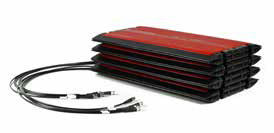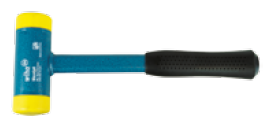RACE RESULT's patented folding ground antenna is the recommended setup for most applications, in particular mass participation running events.

The standard 4.8m ground antenna is comprised of 8 segments of 60cm each, with each element containing an antenna, additional extension kits are available for 6m, or up to 8.4m maximum connected to a single decoder.
By using a ground antenna the distance between antenna and transponder is reduced for all positions and the risk of obstruction between antenna and transponder is also reduced.
Setting up the Ground Antenna
While setting up the ground antenna, please follow these few instructions carefully.
This will ensure correct installation and avoid damage to the antenna and the sensitive coaxial cables.
- Take the antenna out of the box and place it on the ground at the timing location.
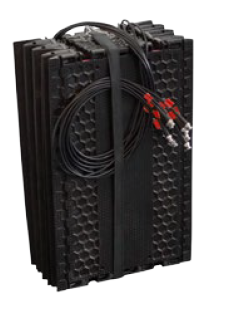
- Open the strap.
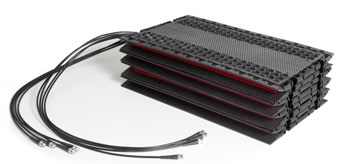
- Simply unfold the elements of the antenna:
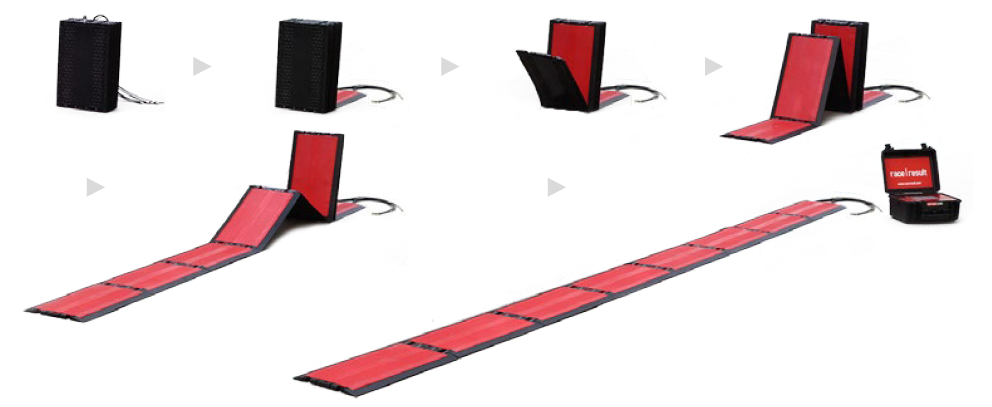
- Connect each antenna cable to the decoder by plugging it in and twisting it clockwise 90 degrees. The cables can be connected in any order.
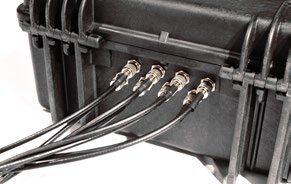
6 m Extension Kit
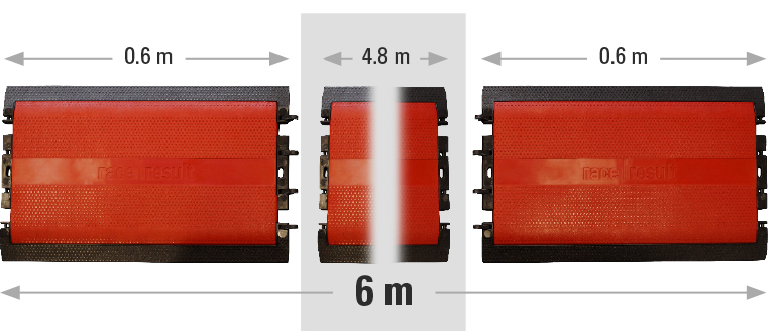
Two empty antenna elements that are attached to either end of the 4.8m ground antenna to extend it by 60cm on either side.
Do this by clipping in the hinge elements; make sure that they do not protrude the surface of the ground antenna.
The red top-plate can be lifted up so that the antenna cables can be routed through the corresponding channels, make sure the cables do not cross each other and are laying flat as they might otherwise be damaged.
Afterwards re-attach the red top-plate, some force might be required and we recommend using a rubber mallet.
Caution should be taken when using ankle or shoe mounted transponders with the 6m extension kit since there is no antenna element on the far end of each mat.
8.4 m Extension Kit
The 8.4m Extension kit can be used to extend the width of the ground antenna for wider timing points, the extension kit includes additional mat elements, dummy antennas and extra long cables.
In the 8.4m configuration the mat contains 6 empty mat elements to spread antennas more evenly across the length, for this reason ankle or shoe mounted transponders should not be used when working with mats which have been extended longer than 4.8m.
Follow these instructions carefully to set up the 8m extension kit for the ground antenna. This will ensure correct installation, and avoid damage to the antenna and the coaxial cables.
Required Equipment
|
4.8m Ground Antenna |
|
|
8m Extension Kit |
|
|
Rubber Mallet (not inlcluded) |
|
Instructions
- Unfold the 4.8m ground antenna and the two elements of the 8m extension kit. Place them in the order displayed below and make sure all antenna cables run in the same direction.
- Remove the lids from the ground antenna. Do this by lifting the red panels from the corner of each antenna element. Make sure not to damage the antenna or the coaxial cables.
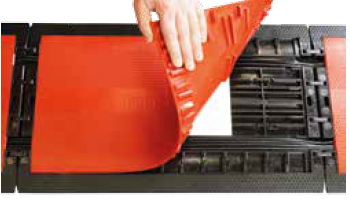
- Replace the antenna in element 2 and 4 of the ground antenna with one dummy antenna element each. Store the remaining antennas in a safe location. Insert the third dummy element into the empty single element antenna mat (element: 0).
The completed antenna should be setup in the following way: every element marked with an “A” has to contain an antenna, every element marked with a “D” has to contain a dummy element.

- Connect the ground antenna to the extension kit. Do this by pressing the hinge joints from the five element antenna mat into the corresponding spaces of the ground antenna. Repeat this to connect the single element antenna mat to the ground antenna. You can use a rubber mallet to simplify this step.

- Place both antenna cables from the five element antenna mat into the channels of the ground antenna and the single element antenna mat. Afterwards place the six antenna cables from the 4,8m ground antenna into the channels of the single element antenna mat.

- Close the lids of all open antenna mats. Ensure that the cables do not cross over within the element. Work in the direction of the cables - starting at element 8, working through to element 0.
Then press or step on the lids in the following order: first at the center of the short sides, next on the corners and finally on the edges of the element. Never hit in the middle of the lid. Use a rubber mallet to simplify this step.
- Connect each antenna cable to the decoder by plugging it in and twisting it clockwise 90 degrees. The cables can be connected in any order.
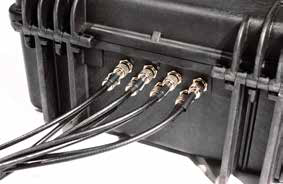
- Perform a brief function test. Switch on the decoder and validate that the antenna is working properly, e.g. by using a Test Transponder.
Splitting a 4.8 m antenna to 2 x 2.4 m
To cover two separate lanes with the same timing line, or to create a main and backup timing line with one decoder, you may want to split your 4.8 m antenna into two parts of 2.4 m.
Note that we do not recommend using a split antenna as a main and backup line on a timing point that requires a high level of precision.
Here is why: a decoder connected to two consecutive timing lines should see two peaks in signal strength for each participant, but it is impossible to define a reaction time that would ensure that these two peaks are systematically treated as two separate detections, regardless of the speed of the participant and the environment. If the second peak is detected before the reaction time has elapsed, the decoder will take the highest peak to record the time, which could be on either timing line.
A single detection line per decoder is the only way to guarantee precision at your finish line. If you are using only one chip per bib, then it is best to use two decoders with one detection line each at the finish. More information about Combining multiple ground antennas and decoders.
A split antenna is however perfect for timing points where you need to improve the read rate and do not need high precision, for example at the swim exit of a triathlon.
You can find more information about the way times are calculated by our passive system in this article about Detection Setup
When connecting 2 lines of mats to a single decoder it is recommended to keep the maximum distance between the 2 mats to a maximum of around 2 meters. When spreading the mats further apart you create 2 distinct read zones each of which is only active half the time due to the multiplexing of the decoder.
The following video shows how to separate your ground antenna.
Combining multiple ground antennas and decoders
When setting up multiple timing lines using ground antennas, there is some key information to understand.
- The most common reason for missed detections is participants directly blocking the transponder with their arm when stopping a GPS watch or device. Spacing lines apart increases the chance that the chip will not be blocked.
- Transponders cannot communicate with 2 different readers at the same time, so a minimum distance of 3 m (recommended 5 m) should be kept between detection lines placed one after the other (e.g. a main line and a backup line). When setting up two systems next to one another to cover a wider detection line, it is better to have a dummy element in the middle, not sending any signal. For this, you can either add one dummy element from an extension, or simply not connect the last element of one of the antennas.
- A decoder will switch through all the connected antennas approximately 25 times per second, at any given time only one antenna is active, using a single decoder is therefore technically reducing the read time on each line.
- If using EU frequency decoders, it is necessary to set the Channel for each decoder accordingly, by default this is set to Auto. There are 2 options "A" and "B", these should alternate between decoders to maximize read rates. This should be set back to Auto when the decoder is used alone.
Use cases:
Two decoders, main and backup:
- Set up the antennas at least 3 meters (recommended 5 meters) apart
- If operating on EU frequencies, make sure to set one decoder to frequency A, the other to frequency B.
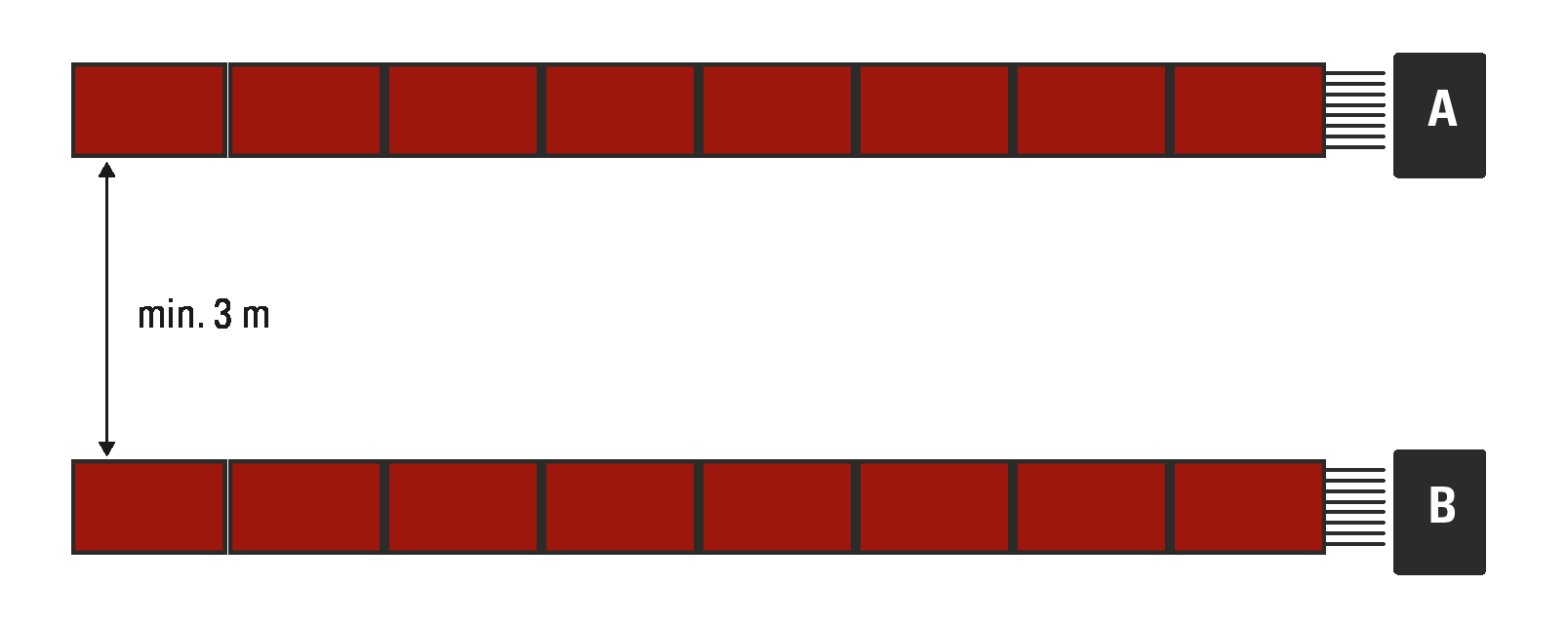
Two decoders side-by-side to cover a wider detection line:
- Use hinges to join antennas in the middle
- Make sure to have one element in the middle not sending any signal. For this, you can either insert one dummy element from an extension, or simply not connect the last antenna on one of the two decoders (connect cables 1-7 of the antenna, leave cable number 8 not connected).
- If operating on EU frequencies, make sure to set one decoder to frequency A, the other to frequency B.

4 decoders, main and backup line, side-by-side:
- Observe the same precautions as in the examples above
- If operating on EU frequencies, alternate frequencies A and B on your decoders as shown below

4 decoders with extension, 16 m main and back up line:
- Remove one dummy element in the middle of each 16 m line, so as not to have 2 dummies side by side. On each line, one side should have 13 elements, the other 14. With 27 elements, you can cover up to 16.2 m.
- Otherwise, observe the same precautions as above.

Technical Specifications
Weight & Pack-Size |
||
| Weight | Pack-Size | |
| 4.8 m Antenna | 25.3 kg | 60 x 40 x 20 cm |
| Antenna Extension Kit | 6.2 kg | 60 x 37 x 5 cm |
| Antenna Height | 2 cm | |
| Antenna Depth | 29 cm | |
Specification |
||
| Antenna Frequency | 865-868MHz (EU), 903-927MHz (US), 920-925MHz (AUS) | |
| TX Power | 33dBm max | |
| Track Width: | 4.8 meters 6 meters with 6m Extension Kit, 8.4 meters with 8m Extension Kit |
|
| Read Range [1] | 4 meters | |
| Detection Rate Read Rate |
> 99.8% [2] > 2,500 tags/min |
|
| Maximum Transponder Speed [3] | 40 km/h, 25 mph | |
| Timing Accuracy [4] | 200 ms | |
[1] Transponders are detected multiple times while crossing the antenna. The detection with the highest signal strength - right above the antenna - is used for timing.
[2] With transponders attached correctly.
[3] Higher speeds are possible, detection rate may be lower.
[4] Use GPS time to get the most accurate results.
